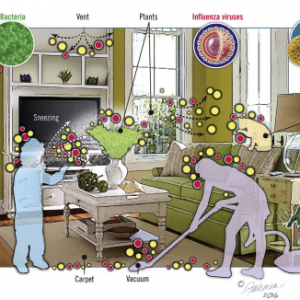I. Introduction There is an oft-cited hierarchy for data, wherein ideally it should flow: Data –>Information –>Knowledge –>Wisdom (DIKW). Just because you have data, it takes some processing to get quality information, and even good information is not necessarily knowledge, and knowledge often requires context or application to become wisdom. For example, you could have …
I’m currently attending the inaugural conference of the Citizen Science Association… “Citizen Science 2015“. Over 650 participants from around the world have arrived in San Jose to talk about all the various flavors and implications of citizen science. It’s been a fascinating conference so far, not least because there’s very little agreement on what the …
When I jetted off to South America a year and a half ago, my doctor sent me with a bottle of Ciprofloxacin in case of an unfortunate bout of food poisoning. I thought little of it then, but what does it mean when millions of travelers head to developing countries with antibiotics? You guessed it …
Great article about a great study. Read them both. Failing that, here’s my short version: A study entitled “Geospatial Resolution of Human and Bacterial Diversity with City-Scale Metagenomics” came out yesterday that is just fascinating on multiple levels. This article describes a large-scale metagenomics study carried out by the PathoMap project at Weill Cornell Medical …
Well, the stories just keep coming about antimicrobial agents we can use to kill off some pathogen in our environment. Today’s is about plasma – yes plasma – and how it can deactivate norovirus in the environment: ‘Cold plasma’ kills off norovirus from the BBC. The article discusses a new study in the journal mBio. Some key …
When we take a swab and perform 16S sequencing we assume that this gives us a picture of who is present in a bacterial community. But actually what we’re measuring is what DNA is present on that surface. This technique doesn’t tell us who is alive, who is dead, who is viable, who is non-viable, …
So – we have been having a running discussion with people in my lab about one key issue in microbiome studies – how does one store samples prior to doing DNA extractions and does it matter? As background for those who do not do this kind of work – the general principle behind DNA based …
By Amanda Makowiecki 1st Year Mechanical Engineering PhD Student Miller Research Group, University of Colorado Boulder Researchers at the University of Oregon recently published a paper examining the connection between architectural design and microbial diversity in our buildings (Kembel et al. 2014). Although occupancy type was identified as the strongest predictor of microbial variation, several …
NOTE (3-12-15): THESE RESULTS ARE INCORRECT. We have left them here for comparison. A blog post describing the problem is here and the correct information can be found here. We’ve finished analyzing all the data from the “Microbial Playoffs” part of Project MERCCURI (described here). Each microbe that was chosen to fly to the International …
IBM and Mars put out a joint press release today announcing a new effort to use metagenomics to study microorganisms in the food supply chain. The new initiative, called the Sequencing the Food Supply Chain Consortium (SFSC), will use metagenomics and metatranscriptomics to establish what they call a “microbial baseline” that can later be used …
